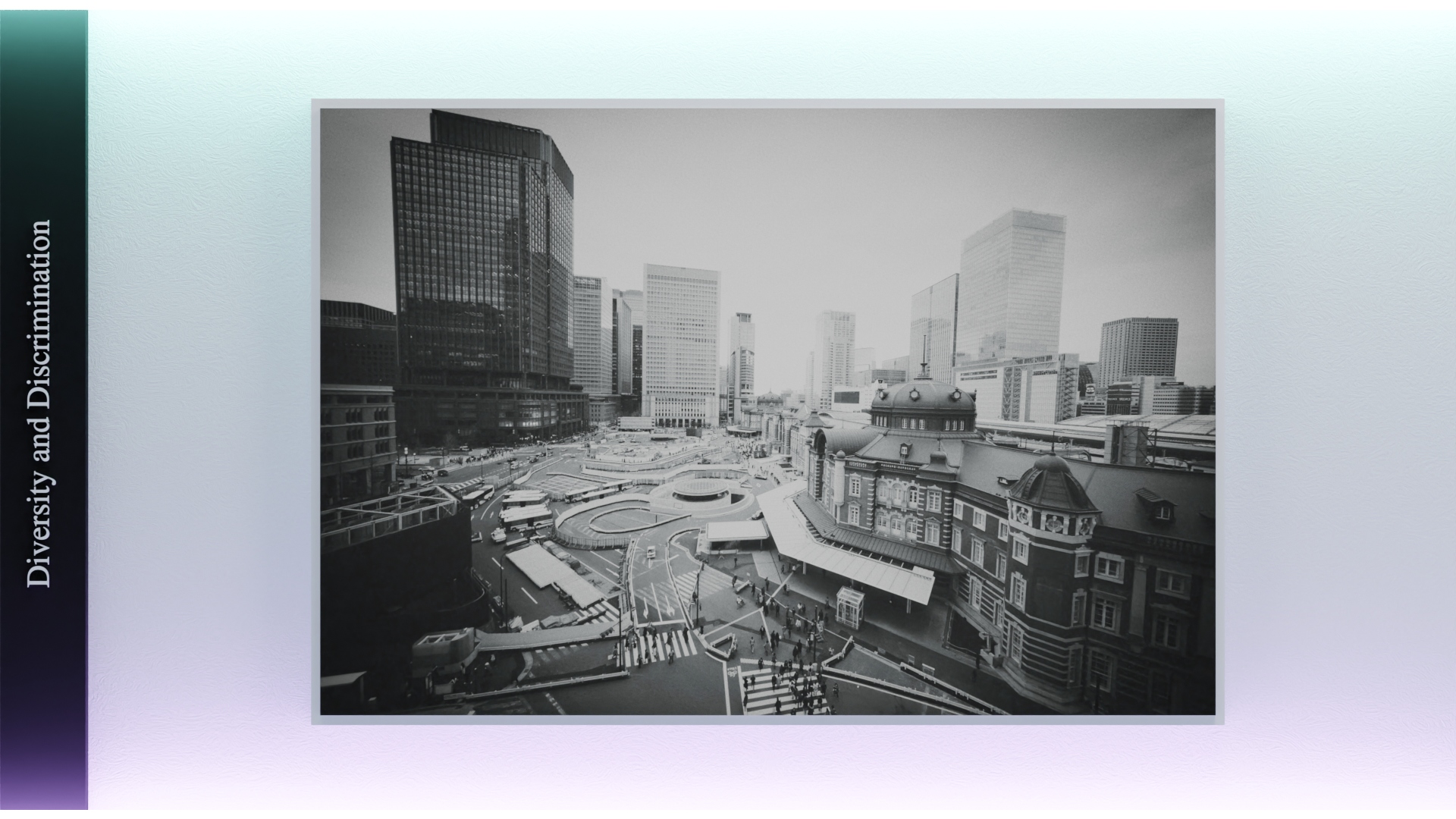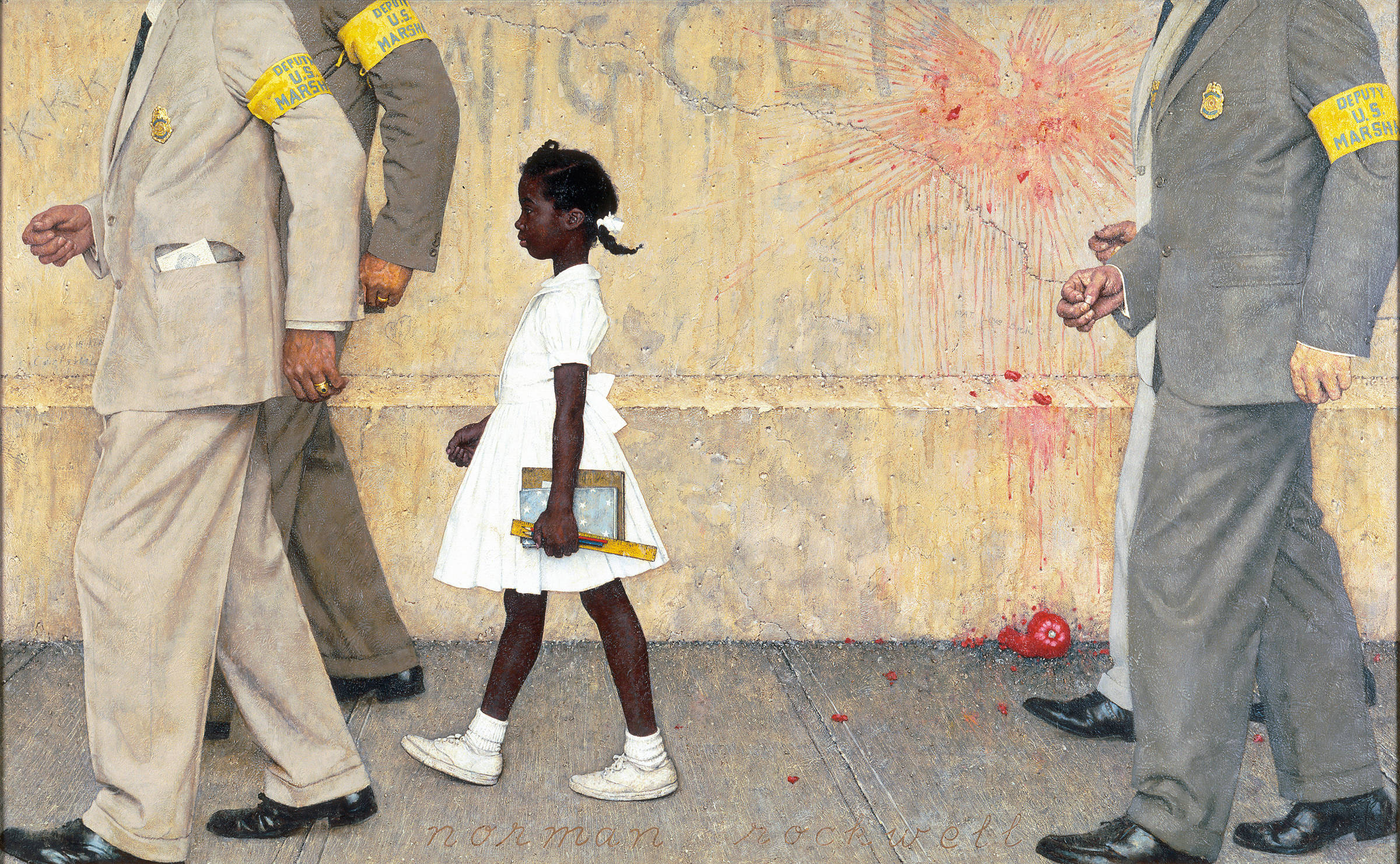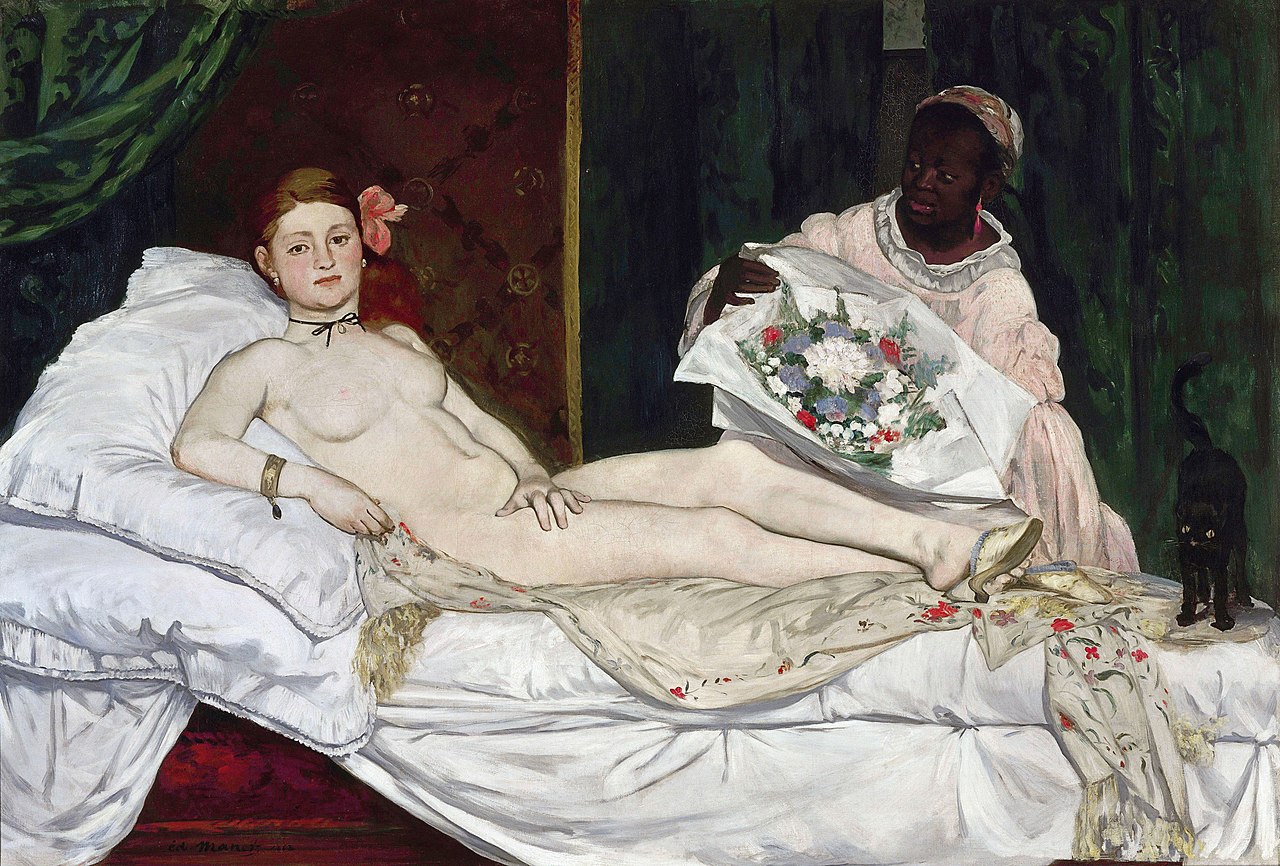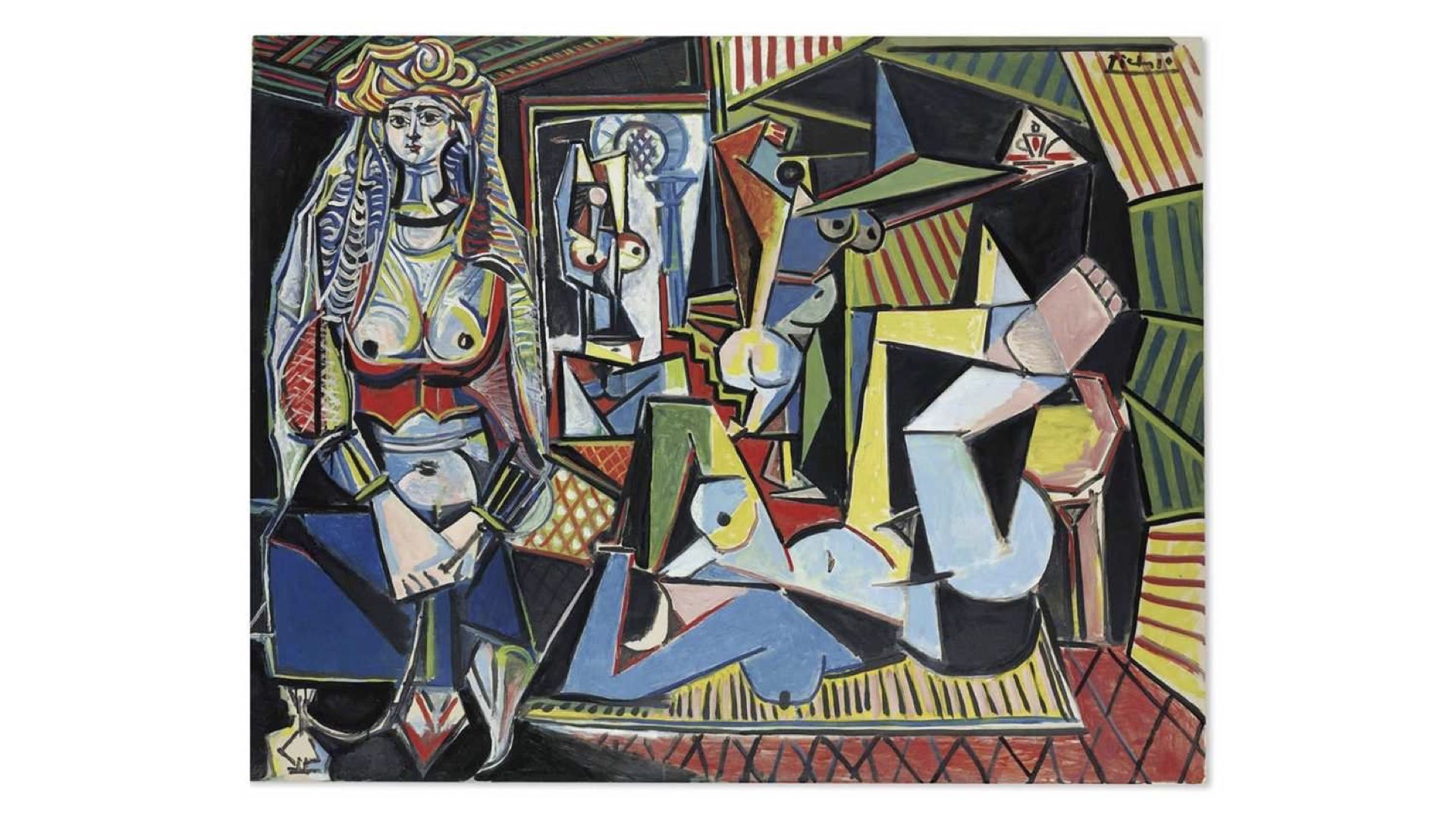
Diversity and Discrimination
When people with different backgrounds, experiences, perspectives, and skills come together, ideas and perspectives are more likely to intersect and generate new ideas and innovations. It is easy to imagine that this is the benefit of diversity and its contribution to solving society's problems.
However, not many people may be aware of how this diversity is established.
Discrimination, prejudice, exclusivity, cultural assimilation, unequal systems, and educational imbalance
are factors that hinder diversity, and are issues that we must be aware of when engaging in creative and
social activities, and that everyone must be aware of now that the Internet has made multi-ethnic and
multi-religious communities the norm. The issues of prejudice and discrimination are not only a matter of
study but also a matter of concern.
The issues of prejudice and discrimination are something that everyone is at risk of doing without being
aware of it unless they study up.
Today, because of the principle of non-retroactivity of law in all worlds and the principle of non-retroactive application prior to the time of enforcement, it is inherently difficult to overturn history that should have been affirmed. However, for example, in the Americas, since the Black Lives Matter movement, there have been cases where statues of Christopher Columbus, who created a structure of domination based on colonial policies, slavery, and white supremacy, have been removed, and people's awareness and ethics of equality and human rights have also changed People's awareness of equality and human rights, as well as ethics, are changing. We are growing our civilization in a world of ethics that demands another level of awareness than the law.
While discriminatory attitudes and behaviors are still and have always been a factor in creating conflict, one might imagine that a reduction in discrimination has the benefit of creating empathy and strengthening social cohesion. Knowing the precedents and history of various forms of discrimination and persecution may also be important to avoid making the wrong decisions on contemporary issues.
異なるバックグラウンド、経験、視点、スキルを持つ人々が集まると、アイディアや視点が交差し、新しいアイディアやイノベーションが生まれやすくなります。これが多様性のメリットであり、社会の課題解決にも貢献することはイメージしやすいと思います。
しかし、その多様性はどのようにして成立するのか、自覚している人は多くないかもしれません。
差別、偏見、排他性、文化の同化、不平等な制度、教育の不均衡などは多様性を阻む要因になり、創作活動や社会活動をする上で気をつけなければならない問題であり、インターネットにより多民族、多宗教のコミュニティが当たり前になっている現在、誰もが意識しなければならない事柄ではないでしょうか。
偏見や差別の問題は、勉強しない限り誰もが無自覚に行う危険性があるものといえるでしょう。
現在、あらゆる世界で法の不遡及の原理があり、施行時以前には遡って適用されない原則があるため、肯定されていたはずの歴史を覆すことは本来は難しいことではありますが、例えばアメリカ大陸ではBlack Lives Matter以降、植民地政策や奴隷制度、白人至上主義に基づいた支配構造を生み出したクリストファー・コロンブスまで遡り、銅像が撤去されるケースが出てきていたり、人々の平等や人権の意識も倫理も変化してきています。法よりももう一段階高い意識が求められる倫理の世界で我々は文明を育んでいます。
差別的な態度や行動は今も昔も変わらず対立を生み出す一因となりますが、差別の減少は共感を生み社会的結束を強化するメリットがあることを想像してみませんか。
さまざまな差別や迫害の前例や歴史を知ることもまた現代の課題に対する判断を間違えないために重要かもしれません。
Diversity
多様性

Norman Rockwell, The Problem We All Live With, 1963, oil on canvas, 36 x 58 inches. Illustration for LOOK, January 14, 1964. Norman Rockwell Museum Collections. ©NRELC, Niles, IL.
Diversity is a delicate thing that can easily be lost with the slightest lack of consideration. Diverse opinions and values are sacrificed in a variety of situations, from society to family, and there are several that you may recognize in your daily life. Below is a list of some of the major factors that inhibit diversity.
- Discrimination and prejudice: Discrimination and prejudice within a society can lead to unequal treatment and exclusion of certain racial, religious, gender, sexual orientation, physical characteristics, and cultural groups. This can result in diversity not being welcomed and some people being excluded or oppressed.
- Organizational Culture: When the culture of an organization or society is directed toward people with certain attributes or characteristics, diversity is unwelcome and a culture of uniformity permeates. This prevents people with different backgrounds and perspectives from fully flourishing within the organization.
- Education: If the educational system does not respect diversity and emphasizes only certain perspectives and cultures, the ability of the next generation of individuals to understand and respect diversity may be diminished.
- Economic factor: Economic inequality reduces diversity by limiting the opportunities and resources to which the less affluent have access.
- Policy and Law: It affects diversity in society depending on whether policies and laws are discriminatory or promote diversity.
- Social pressure: General societal pressures and norms may encourage or discourage certain behaviors and opinions. If a culture of diversity is not nurtured, individuals may have difficulty embracing diversity.
- Lack of communication: When people from different backgrounds do not communicate well, misunderstandings and prejudices can develop, making diversity less acceptable.
These factors are interrelated and are commonly found in societies and organizations. Fostering a culture of respect for diversity is important not only for the world of creatives, but for society as a whole, as the promotion and respect of diversity brings many benefits, including social equity, creativity, innovation, and problem-solving skills.
多様性はちょっとした配慮不足で簡単に失われてしまう繊細なものです。社会から家族までさまざまな場面で、多様な意見、価値観は犠牲になってしまうもので、皆さんの日常でも身に覚えがあることはいくつかあるのではないでしょうか。以下に多様性が阻害される主要な要因をまとめました。
- 差別と偏見: 社会内の差別や偏見が、ある特定の人種、宗教、性別、性的指向、身体的特徴、文化などのグループに対する不平等な扱いや排除を引き起こすことがあります。これにより、多様性が歓迎されず、一部の人々が排除されたり抑圧されたりすることがあります。
- 組織の文化: 組織や社会の文化が、特定の属性や特徴を持つ人々に向けて発信される場合、多様性は歓迎されず、一律の文化が浸透します。これにより、異なるバックグラウンドや視点を持つ人々が組織内で十分に活躍できなくなります。
- 教育: 教育制度が多様性を尊重せず、特定の視点や文化のみを重視する場合、次世代の個人が多様性を理解し尊重する能力が低下する可能性があります。
- 経済的要因: 経済的な不平等は、裕福ではない人々がアクセスできる機会や資源が制限されることにより多様性が減少します。
- 政策と法律: 政策や法律が差別的であるか、多様性を促進するかによって、社会での多様性に影響を与えます。
- 社会的圧力: 一般的な社会的圧力や規範が、特定の行動や意見を奨励または抑制することがあります。多様性を受け入れる文化が育まれない場合、個人が多様性を受け入れることが難しくなる可能性があります。
- コミュニケーションの不足: 異なるバックグラウンドを持つ人々が十分にコミュニケーションをとらない場合、誤解や予断が生まれ、多様性が受け入れられにくくなることがあります。
これらの要因は相互に関連しており、社会や組織で一般的に見られます。多様性の促進と尊重は、社会的な公平性、創造性、イノベーション、課題解決能力など多くの利点をもたらすため、多様性を尊重する文化の醸成はクリエイターの世界のみならず社会にとって重要な事柄です。
Majority and Minority
マジョリティーとマイノリティ

Judy Chicago, Wing Two from The Dinner Party, 1979, embroidery on linen and china paint on porcelain,
Elizabeth A. Sackler Center for Feminist Art, Collection of the Brooklyn Museum. © Judy Chicago/Artists
Rights Society (ARS), New York Photo © Donald Woodman/Artists Rights Society (ARS), New York
https://judychicago.com
Groups form loosely in society, and it is inevitable that majorities and minorities will emerge.
Minorities are often the targets of persecution due to various factors such as race, religion, sex,
disability, age, and economics, and are often unreasonably discriminated against because of their natural
attributes that cannot be resolved through individual efforts.
The Holocaust of the 1930s, Apartheid that lasted from 1948 to 1994, the Rwandan genocide of 1994, the
Rohingya crisis of 2017, and other instances of minorities being persecuted by the majority ethnic group
have historically occurred around the world and are not issues of the past.
In addition, we can see examples of failed assimilation policies and colonialist ways of creating
communities in various nations throughout the two world wars, which focused only on the majority and used
the values of the majority to dominate and control the minorities as a whole.
Often in these situations, the explanation is given by the strong as the contribution of the strong to the
weak who lack civilization, but from the perspective of the weak, colonial rule would seem quite different.
In such nations, diversity of expression is denied and creativity is stagnant.
It could be said that the major artistic change of the 20th century was that ethnic minorities persecuted in
Europe found asylum in the United States, which was not a war zone, and created a new culture and
history.
In addition, many of the behaviors that majorities direct toward minorities are discriminatory.
Efforts to ensure legally and ethically that there is an equal, fair, and transparent relationship between
majorities and minorities, and that diversity and equality are respected, are essential to resolving this
issue.
It is important for a culture to embrace people of different backgrounds and identities, to respect diverse
points of view, and to create an environment where everyone can flourish fairly.
社会の中ではゆるやかに集団が形成され、マジョリティーとマイノリティーが生じてしまうことは避けることができません。
人種、宗教、性、障害、年齢、経済などさまざまな要因でマイノリティは迫害の対象になりやすく、個人の努力では解決ができない持って生まれた属性を理由に理不尽に差別されてしまうことも少なくありません。
1930年代のホロコースト、1948年から1994年まで続いたアパルトヘイト、1994年のルワンダ虐殺、2017年のロヒンギャ危機など、少数民族が多数派の民族から迫害を受ける事例などが歴史的に世界各地で発生しており、決して過去の話ではない問題です。
また、マジョリティにのみ目を向けて、マジョリティの価値観でマイノリティを飲み込んで全体を統率していくような同化政策、植民地主義的なコミュニティーの作り方の失敗例は2度の世界大戦を通じてさまざまな国家に見ることができると思います。
こういった状況下ではしばしば、文明がない弱者のために強者が貢献したという説明が強者の側からなされますが、弱者の側から見た植民地支配は全く異なる印象でしょう。
そういった国家では多様な表現は否定され、創造性は停滞しています。
ヨーロッパで迫害を受ける少数民族が戦地になっていないアメリカに亡命し、新しい文化、歴史を作ったのが20世紀の大きな芸術の変動とも言えるでしょう。
また、マジョリティがマイノリティに向ける行動には差別的なものも多く含まれます。
マジョリティとマイノリティの間で平等と公平な透明性がある関係性が法的にも倫理的にも確保され、多様性と平等を尊重する取り組みが、この問題の解決に向けて不可欠です。
多様な創造性の大敵こそがマジョリティーによる差別、偏見です。異なるバックグラウンドやアイデンティティを持つ人々を受け入れ、多様な立場からの意見を尊重し、誰もが公平に活躍できる環境を整えることは文化にとって重要です。
Sexism
性差別

Édouard Manet, Olympia , 1863–65, Oil on canvas, 130.5 cm × 190 cm (51.4 in × 74.8 in), Musée d'Orsay, Paris
Discrimination against women is a social injustice that negatively affects individuals and society as a
whole. International organizations, governments, and civil society groups are working to protect women's
rights and narrow the gender gap, and efforts to eliminate discrimination against women are underway in
various organizations.
For example, countries such as Iceland and Norway are actively working to narrow the wage gap through
policy, legal, and social cultural changes. However, there are still many countries, including Japan, where
improvements have not yet been made.
The fact that discrimination against women is still ongoing is a deep-seated problem that has not been
solved for millions of years since the beginning of mankind.
Below is a summary of typical discrimination against women.
- Wage differential: The gender pay gap refers to the inequality in pay between men and women in the same job category or with comparable skills. This disparity is caused by a number of factors. For one, women are placed in lower positions than men and have limited opportunities for advancement. Another is that women often take parental leave, which can create a disconnect in their careers. The wage gap is one of the reasons why women are placed at an economic disadvantage.
- Promotion inequality: In many workplaces, there are few women in top-level positions, and women have limited opportunities to advance to senior management and leadership positions. Women also tend to be less likely to have the support of their supervisors and other key stakeholders, which is important for promotion. Women may also miss out on promotion opportunities because their leadership style differs from that of men.
- Work-life balance: In many societies, women feel pressure to balance family and work. Lack of parental leave and flexible working conditions, as well as the disproportionate division of household labor, are factors that limit women's ability to continue their careers. To address this challenge, it is necessary to promote gender equality and develop childcare support systems.
- Access to education: In some regions, women have limited access to education, and limited access to education increases the likelihood that they will be disadvantaged in economic opportunities and career choices. In addition, in some regions, women are expected to marry and have children early, which may affect their ability to continue their education. Early marriage and childbearing can interrupt studies and limit access to education. Social gender stereotypes and role divisions may dictate that women should focus on family and marriage rather than education.
- Sexual harassment: Sexual harassment refers to offensive behavior based on gender, such as verbal abuse, inappropriate gestures, or uncomfortable attention that women receive in the workplace or in public. Sexual harassment can harm the victim's mental health and undermine the safe environment of the workplace. It can expose women to an uncomfortable work environment and cause them to lose confidence in their ability to advance.
- Violence and abuse: Domestic violence and sexual abuse are serious problems against women, not only because of their physical and psychological effects, but also because they are forms of social discrimination against women. Legal protection and support systems need to be strengthened to combat these acts of violence.
- Underrepresentation of politics: In many countries, women have fewer representation opportunities than men in political decision-making. In order for women to actively participate in the political arena and influence policy decisions, the political system must be reformed.
女性差別は個人や社会全体に悪影響を及ぼす社会的な不正義とよべるものです。国際的な機関や政府、市民社会団体は女性の権利保護とジェンダーギャップの縮小に向けて取り組んでおり、女性差別の撤廃に向けた取り組みはさまざまな組織で進行中です。
例えば、アイスランドやノルウェーなどの国々では、政策、法律、社会的な文化の変化によって賃金格差を縮小しようと積極的な取り組みが行われています。しかし、日本をはじめ依然として改善が進まない国も多く存在します。
女性差別は現在も進行中であるということは人類が始まって何百万年も経過しているにも関わらず解決しなかった根深い問題と言えるでしょう。
以下に代表的な女性差別をまとめます。
- 賃金格差: 男女間の賃金格差は、同じ職種や同等のスキルを持つ男性と女性の間で給与に不平等があることを指します。この格差は、さまざまな要因によって引き起こされます。一つは、女性が男性よりも低いポジションに配置され、昇進機会が限られていることです。また、女性が育児休暇を取ることが多いため、キャリアにおいて断絶が生じることもあります。賃金格差は、女性が経済的に不利な状況に置かれる原因の一つです。
- 昇進の不平等: 多くの職場で、最上層のポジションに女性が少なく、女性は上級管理職やリーダーシップポジションに昇進する機会に制約があります。また、昇進においては上司や重要な関係者の支持が重要となりますが、女性はこの支持を得にくい傾向もあります。リーダーシップのスタイルが男性のやりかたとは異なるという理由で、女性が昇進の機会を逃すこともあります。
- 家庭と仕事のバランス: 多くの社会で、女性は家庭と仕事の両立を図らなければならないプレッシャーを感じています。育児休暇や柔軟な労働条件の不足、家事労働の不均衡な分担などが、女性がキャリアを続けることに制約をかける要因となっています。この課題に対処するためには、男女共同参画の促進や育児支援制度の整備が必要です。
- 教育へのアクセス: 一部の地域では女性が教育を受ける機会に制約があり、教育を受ける機会が制限されると、経済的な機会や職業選択においても不利益が生じる可能性が高まります。また、一部の地域では、女性が早期に結婚し、出産することが期待されることがあり、これが教育の継続に影響を及ぼすことがあります。早期の結婚と出産は、学業を中断させ、教育へのアクセスを制限します。社会的なジェンダーステレオタイプや役割分担により、女性は教育よりも家庭や結婚に焦点を当てるべきだとされることがあります。
- 性的ハラスメント: 性的ハラスメントは、女性が職場や公共の場で受ける暴言、不適切なジェスチャー、不快な注目など、性別に基づく不快な行動のことを指します。性的ハラスメントは、被害者のメンタルヘルスに害を及ぼし、職場の安全環境を損ないます。女性が不快な職場環境にさらされ、昇進に対する自信を喪失することがあります。
- 暴力と虐待: 家庭内暴力や性的虐待は女性に対する深刻な問題であり、身体的、精神的な影響を及ぼすだけでなく、社会的な女性差別の形態でもあります。これらの暴力行為に対抗するためには、法的な保護や支援体制の強化が必要です。
- 政治的代表不足: 多くの国で、女性が政治的な意思決定において男性よりも少ない代表機会を持っています。女性が政治の舞台で積極的に参加し、政策決定に影響を与えるためには、政治的なシステムの改革が求められます。
Structural Discrimination
構造的差別

Pablo Picasso, Les Femmes d'Alger (Version O) English: The Women of Algiers, 1955, Oil on canvas, 114 cm × 146.4 cm (45 in × 57.6 in), Private collection of Hamad bin Jassim bin Jaber Al Thani, Doha, Qatar
The problem that naturally creates an uncomfortable and disadvantageous situation for minorities due to some
kind of "privilege" that has favored some majorities even without a sense of discrimination is called
"structural discrimination.
In some societies and organizations, people on the majority side are unaware of the "privileges" that come
with the attributes they automatically acquire without effort on their part. In many cases, minorities may
be labeled as "reverse discrimination" for their actions to correct disparities, because they are unaware of
the privileges they have.
The concept of structural discrimination is particularly important to be aware of in the context of
discrimination against women in male-dominated societies, which is often identified as a barrier to women's
advancement in society.
Although half of the world's population is female, structural discrimination must often be the cause of the
lack of women in their organizations.
In many cases, the gender wage gap stems from men and women choosing different occupations and industries.
Men often go into high-paying STEM (science, technology, engineering, and math) fields, while women often go
into lower-paying fields such as nursing and education, resulting in differences in average wages.
It is also well-documented that female office workers can have a big difference in career advancement and
salary after a few years depending on whether their boss is of the same or opposite gender.
Male organizations selected by men in charge of human resources create a culture that favors men, resulting
in an organization that is uncomfortable for women, even if this is not intentionally so. In such
organizations, it is extremely difficult for women to rise above their male counterparts. Structural
discrimination occurs in environments where there is no awareness of male privilege.
There are many attributes that give rise to privilege, including gender, race, religion, education, economic
status, and area of residence, but gender privilege in particular is often used most unknowingly and has
become an important issue in building companies and organizations these days.
Discrimination is something that everyone does unknowingly unless they study it, and in many cases, they are
even unaware that they are discriminating.
However, the discriminated party will never forget it for a long time.
In considering discrimination, it is important to be aware of the concept of "structural discrimination"
that is implicitly created by the organization rather than an individual problem.
差別意識がなくとも一部のマジョリティが優遇されてきた何らかの「特権」が原因でマイノリティにとって居心地が悪い不利な状況が自然と生まれてしまう問題は「構造的差別」と呼ばれます。
社会や組織の中ではマジョリティ側の人たちが自身が努力することなく自動的に獲得している属性がもたらす「特権」に気付いていないことがあります。マイノリティが格差を是正するため主張する行動に対して「逆差別」とのレッテルを貼ってしまうこともマジョリティ側が自ら持つ特権に気付いていないため、逆に不平等を感じてしまうということが多々あるでしょう。
構造的差別という概念は特に、男性社会における女性差別の文脈で意識すべき重要な事柄で、女性の社会進出を阻んでいることもしばしば指摘されます。
世界人口の半分は女性であるのにもかかわらず、その組織に女性が少ない原因は構造的差別に起因していることも少なくないはずです。
多くの場合、男女の賃金格差は、男性と女性が異なる職種や業界を選ぶことに起因しています。男性が高給のSTEM(科学、技術、工学、数学)分野に進むことが多く、女性は看護や教育などの低賃金分野に進むことが多いため、平均賃金に差が生じます。
女性の会社員は上司が同性であるか異性であるかで数年後の出世や給料に大きな開きが出てしまうこともよくデータ化されていることです。
人事権を持つ男性によって選ばれた男性組織は男性に都合がいいように風土が作られるため、わざとそうしているわけではないにせよ結果的に女性にとって居心地が悪い組織になってしまいます。こういった組織で男性を跳ね除けて女性が出世するのは至難の業です。男性の特権性が意識されることがない環境では構造的差別が起こっています。
特権を生じさせる属性は性別、人種、宗教、学歴、経済的地位、居住地域などさまざまなものがありますが、特に性別の特権は最も無自覚に利用されていることが多く、昨今では会社や組織の構築でも重要な課題となっています。
差別は勉強しないかぎり誰もが無自覚に行ってしまうものですし、差別していることに気付いていないケースすら多く存在します。
しかし、差別された側はその仕打ちをずっと忘れることはありません。
差別を考える上では個人の問題というより、その組織が暗に作り上げている「構造的差別」という概念に意識を向けることも重要ではないでしょうか。
Racism: History and Present
人種差別の歴史と現在

One of the most impactful discrimination issues in the history of mankind has been the issue of racism. However, not all discrimination is racism, and shelving other issues and focusing only on racism may also be a form of minority discrimination. Here I would like to consider the application of the principles of racism to a variety of other forms of discrimination.
In the past, colonial rule and industrialization depended on slavery. Racism was openly practiced and
increasingly reinforced in the 18th and 19th century world to justify slavery for its economic benefits.
The benefits of cheap labor and economic growth were enjoyed not only by Europe but also by other countries
around the world. Even in Japan, where I was born, fast fashion and food products based on cheap African
labor still abound, and are not exclusive to Europe.
North Korea exports slaves to China and Russia to work in concentration camps, and in 2017, the UN
sanctioned intercontinental ballistic missiles and repatriated slaves to North Korea.
In 2019, China admitted to having facilities called re-education camps in the Uyghur region, where Muslim
Uyghurs are forced to work on cotton plantations and in factories. Fast fashion from big corporate brands
made there could be in your home.
Even today, when slavery is supposedly being reconsidered as a negative history, an economy based on the
exploitation of cheap labor remains deep-rooted in every region and on every scale, and even in Japan, where
I live, there are still examples of exploitation of students, and
female workers and "OTIT - Organization for Technical Intern Training" for
foreigners.
In particular, the "OTIT" is a system that, according to the International Labor Organization's (ILO)
definition of slavery, allows foreign nationals to be bought and sold without regard to their human rights,
and, similar to the kafala system in the Middle East, companies confiscate their passports and force them to
perform forced labor.
As many as 72.6% of businesses are in violation of the law by 2021. It is doubtful that we can say that this
is different from the slavery of the Age of Discovery.
According to the International Labor Organization (ILO), in 2021 there will be 50 million slaves worldwide
and 21.3 million people will be forced into forced labor, the highest number in history. There are more
slaves today than there were in the past, when slavery was taught in history class.
3.3 million of these are children; 22 million women are trafficked into forced marriage or child marriage;
6.3 million women are forced into sexually forced labor; and more than half of all slaves are women. Women
account for 70% of modern-day slaves.
Slavery as an institution may be over, but slavery as a reality is by no means over, we are just unaware of
what exists so close to us.
Can you all say that you do not live in a structure that exploits those who are in a weaker position than
your side for profit?
I believe that becoming aware of the fact that minorities have always tended to be persecuted, ignored, and
exploited is the first step toward a diverse and creative world.
The disadvantages brought about by attributes that cannot be changed by one's own efforts, such as gender,
age, and origin, cannot be put away by the theory of self-responsibility; it is the consideration of those
who have the privilege of being born with them that is important.
Redistribution of wealth that is not limited to economic aspects is the way to contribute to the
construction of a society in which diverse people can freely play an active role.
人類の歴史の中で最もインパクトを与えた差別の一つに人種差別の問題が挙げられると思います。
しかし、差別の全てが人種差別ではありませんし、他の問題を棚上げにして人種差別のことばかり取り上げてしまうこともまた、マイノリティ差別の一つになってしまうかもしれません。
ここでは人種差別の原理から他のさまざまな差別への応用を考えていきたいと思います。
かつての植民地支配と産業化は、奴隷制度に依存していました。経済的利益をもたらす奴隷制度を正当化するために人種差別が公然と行われ、ますます強化されたのが18-19世紀の世界です。
安価な労働力が提供され、経済が成長した恩恵はヨーロッパに限らず世界各国が受けており、私が生まれた日本で考えても、現在なおアフリカの安価な労働力を土台にしたファストファッションや食料品は溢れており、決してヨーロッパだけの他人事ではありません。
北朝鮮は強制収容所で働く奴隷を中国とロシアに輸出していますが、2017年の大陸間弾道ミサイルの制裁で国連は奴隷を北朝鮮に送還するなどしています。
2019年、中国はウイグル地区に再教育収容所と呼ばれる施設があることを認め、そこではイスラム教徒のウイグル人が綿花農園や工場で強制労働を強いられています。そこで作られた大企業ブランドのファストファッションはあなたの自宅にあるかもしれません。
奴隷制度が負の歴史として、反省されているはずの現代においても、安価な労働力を搾取することで成り立つ経済というのは、どの規模でもどの地域でも実は根深く残っており、私が居住する日本でも外国人技能実習制度や学生、女性の労働力を搾取する例は健在です。
その特権性を搾取、差別だと認識すらしていないケースは多いでしょうが、特に「外国人技能実習制度」については国際労働機関(ILO)の奴隷の定義に照らし合わせると、人権を無視されてものとして売買されたり、中東のカファラ制度などと同様に企業がパスポートを没収して強制労働を強いる実態があったり、2021年には72.6%もの事業者が法令違反をおこなっており大航海時代の奴隷とは違うと言い切れるのか疑問です。
国際労働機関ILOによると2021年には全世界に奴隷は5000万人おり2130万人が強制労働をさせられ、その数は歴史上最多です。歴史の授業で習った奴隷制度が存在していた過去よりも現在の方が奴隷の数は多いのです。
そのうち330万人は子供です。2200万人の女性は人身売買による強制結婚や児童婚をさせられています。630万人の女性は性的な強制労働をさせられています。現代奴隷の7割は女性が占めています。
制度としての奴隷は終わっていても、実態としての奴隷は決して終わってなどいなく、我々のすぐ身近に存在しているものに気付いていないだけという問題があるのではないでしょうか。
みなさんは利益のために自分側よりも立場が弱い人を搾取するような構造の中に生きてはいないと言い切れるでしょうか。
マイノリティはいつでも迫害され無視され、搾取させる傾向にあることに意識を向けることが、多様性のある創造的な世界への第一歩になることを信じています。
性別や年齢、出自など自分自身の努力で変えることができない属性がもたらす不利益は自己責任論で片付けられるものではなく、持って生まれた特権を持つ側の配慮こそが重要で、経済面に留まらない富の再分配こそが多様な人々がのびのびと活躍できる社会に貢献できる道なのではないでしょうか。
Eugenics
優生思想

Nintendo, Pokémon Diamond and Parl, Japanese: ポケモン ダイアモンドアンドパール, 2021, Switch
Linked also to war, perhaps the most foolish idea created by humanity in the 20th century is eugenics. This ideology is based on the eugenics idea that people who are biologically or genetically inferior or unproductive in aspects such as physical ability or intelligence have no value in life, and that artificial intervention in reproduction is used to encourage the birth of superior people and prevent the birth of inferior people.
However, I believe that everyone, especially creators, understands that the superiority of human beings
cannot be measured only from one aspect of productivity or biological angle. There are many creators who are
necessary for society, even if they are not the most popular creators or those who earn a lot of money. If
we deny the existence value of such creators from the standpoint of productivity, the world will become a
much smaller place.
In addition, when superiority or inferiority is judged based on a eugenicist approach, the reality is that
judgments are often made based on the majority's values, a phenomenon that is no different from an
imperialist, colonialist structure in which the majority simply assimilates and incorporates the minority.
So, can we say that this eugenic concept really came to an end with the mistakes of World War II?
Like the issue of slavery, this concept may have changed its language and still exists in our immediate
surroundings today.
It is still fresh in our minds that the selection of human lives to be left behind was discussed as hospital
beds became tighter in COVID-19.
It may be difficult to avoid in any country if we live in a modern society that human abilities are assigned
a superiority or inferiority.
However, bringing danger to a person's survival or harming his or her dignity can be called eugenics without
regard for human rights.
We cannot think in the same way as racehorse breeding, food breeding, or Pokemon eggs.
Human beings have human rights.
Have you ever seen cases where the strong, especially in a highly competitive society, deny the survival of the weak or show no concern for human rights? As with the issue of discrimination, unless we study and are aware of it, everyone may be prone to make eugenic-like judgments. These issues are often taboo subjects, but I believe it is important for us, as members of a diverse, rich, and open society, to continue to think about them.
戦争ともリンクし、20世紀の人類が生み出した最も愚かな思想は優生思想かもしれません。 身体能力や知能のような面で生物学的、遺伝的に劣る人間、生産性が無い人間には生きる価値を持たないと考え、生殖に人為的介入を行い、優れた人の出生を奨励し、劣った人の出生を防止するという優生学の考え方を土台にした思想です。
しかし人間の優劣は生産性や生物学的な角度の一面のみから測ることなどできないことは、特にものを作るクリエイターであれば誰もが理解していることではないかと思います。多くの人から人気があるクリエイターや、たくさんお金を稼いでいるクリエイターではなくとも、社会に必要な存在となっているクリエイターはごまんといることでしょう。生産性という一点からそういったクリエイターの存在価値を否定してしまったら、世界は随分と矮小化ししてしまいます。
また、優生思想的な考え方で優劣を判断される場合、実態としてはマジョリティーの価値観で判断がなされることが多く、単にマジョリティーがマイノリティーを飲み込む帝国主義、植民地支配的な構図と変わらない現象が生じます。
では、この優生思想は本当に第二次世界大戦の過ちと共に終焉を迎えたと言えるでしょうか?
奴隷の問題同様この概念も言葉を変えて私たちの身近に現在も存在しているかもしれません。
コロナ禍で病床が逼迫し、残すべき人間の命の選別が議論されたことは記憶に新しいです。
人間の能力に優劣を付けられてしまうことは現代社会で生活していればどの国でも避けて通ることは難しいかもしれません。
しかし、その人の生存に危機をもたらしたり尊厳を傷つけることは人権を無視した優生思想と言えると思います。
競走馬の交配、食物の品種改良、ポケモンの孵化厳選とは同じ考え方をすることはできません。人間には人権があります。
特に競争が厳しい社会での強者は弱者の生存を否定してしまったり、人権に無配慮になるケースを見たことがないでしょうか。
差別の問題同様、勉強して意識しない限り誰もが優生思想のような判断を行ってしまいがちなのが人間かもしれません。こういった問題はタブー視されがちな議題ですが、絶えず考え続けることが多様で豊かな開かれた社会を構成する一員として大切なのではないでしょうか。
Conclusion
まとめ
I may not be in a pleasant mood because I have covered a serious topic.
However, I believe that if we eliminate discrimination and prejudice and act with respect for the human
rights of people of all attributes, we will always find ourselves surrounded by a diverse group of people,
and it is certainly true that creativity and innovation are more likely to occur in places where diverse
people gather.
By embracing new cultures and perspectives from people of different backgrounds, we can improve our
interpersonal skills and cognitive flexibility, which can lead to the acquisition of human richness.
Wouldn't you be excited to be closer to such a world?
It may be difficult to understand diversity and practice expression when creators avoid this issue of discrimination. This may be the first thing that everyone should learn. I think there are still some things that I am not aware of. If you find something wrong, I would be happy to hear your comments using the form at the bottom of this page.
シリアスなテーマを取り上げたため、楽しい気分ではなくなってしまったかもしれません。
しかし、差別や偏見を取り除き、あらゆる属性の人たちの人権を尊重した行動をしていれば、必ずや自分の身の回りは多様な人が集まってくるものですし、多様な人が集まる場所ではクリエイティブなことやイノベーションが起きやすいことは確かであると私は考えます。
様々なバックグラウンドの人の新しい文化や視点を受け入れることで、対人スキルや認知的な柔軟性が向上し、人間としての豊かさを獲得することにも繋がります。
そういった世界に近づくことにワクワクしませんか?
クリエイターがこの差別の問題を避けて通ったところで多様性の理解と表現の実践は難しいのではないでしょうか。本来、誰もが最初に学ぶべき事柄かもしれません。
私もまだ認識が間違っていることが多々あると思います。おかしいと感じたことがあればぜひ最下部のフォームからご意見をいただけると嬉しいです。







